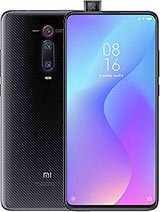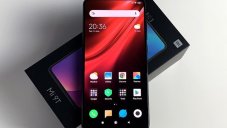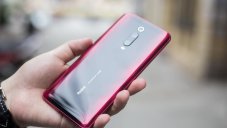Xiaomi Mi 9T
$275 | 24990
- 6.39" 1080x2340 pixels
- 48MP 2160p
- 6GB RAM Snapdragon 730
- 4000mAh Li-Po
Phone Finder
- Acer alcatel Allview Amazon Amoi Apple Archos Asus AT&T Benefon BenQ BenQ-Siemens Bird BlackBerry Blackview BLU Bosch BQ Casio Cat Celkon Chea Coolpad Cubot Dell Doogee Emporia Energizer Ericsson Eten Fairphone Fujitsu Siemens Garmin-Asus Gigabyte Gionee Google Haier HMD Honor HP HTC Huawei i-mate i-mobile Icemobile Infinix Innostream iNQ Intex itel Jolla Karbonn Kyocera Lava LeEco Lenovo LG Maxon Maxwest Meizu Micromax Microsoft Mitac Mitsubishi Modu Motorola MWg NEC Neonode NIU Nokia Nothing Nvidia O2 OnePlus Oppo Orange Oscal Oukitel Palm Panasonic Pantech Parla Philips Plum Posh Prestigio QMobile Qtek Razer Realme Sagem Samsung Sendo Sewon Sharp Siemens Sonim Sony Sony Ericsson Spice T-Mobile TCL Tecno Tel.Me. Telit Thuraya Toshiba Ulefone Umidigi Unnecto Vertu verykool vivo VK Mobile Vodafone Wiko WND XCute Xiaomi XOLO Yezz Yota YU ZTE
Xiaomi Mi 9T Summary
Xiaomi Mi 9T is essentially the international version of the Redmi K20 launched earlier in the Chinese market. The product is available in 2 versions: 6GB RAM / 64GB internal memory and 6GB RAM / 128GB internal storage.
Display
The Mi 9T's screen has the same specifications as the Mi Mix 3, including a 6.39-inch Super AMOLED panel, Full-HD + resolution, a pixel density of 403 PPI and HDR support. Perhaps the two handsets share the same panel.
In practical use, the screen of Mi 9T fully shows the characteristics of AMOLED panels: bright colors, deep blacks, high contrast, and wide viewing angle. Not just that, the screen of Mi 9T supports watching HDR videos with images more vivid and vibrant than conventional videos.
However, you should know that the display quality of this phone is still inferior when compared to the top products using Samsung and Apple Super AMOLED panels. When placed side by side, the Super AMOLED screens on Galaxy S10, Note 9, or iPhone XS Max phones look brilliant, clearer, and more prominent.
Like Samsung, Xiaomi also brings to this screen different color and contrast modes. In particular, the default mode will display the bright colors usually seen on AMOLED panels, while the standard mode simulating the sRGB color band that has more accurate color accuracy but will look pale and warmer.
In terms of sound, Mi 9T has only one external speaker located on the bottom edge, no extra speaker as a dual speaker like some other smartphones. The speakerphone of the phone is quite low, on par with the Oppo Find X that I'm using but when increasing the volume to the maximum, the sound gets a bit distorted.
Performance
Compared to Mi 9, performance is the only point Mi 9T cuts to match its mid-range price. The device is not equipped with the high-end Snapdragon 845/855 chip series but switched to Snapdragon 730. However, this chip is still enough to deliver a good experience on the Mi 9T.
On performance measurement apps, the Mi 9T is not inferior to any smartphone in the same price range. In particular, the performance score of the device far exceeds that of a competitor from Samsung, the Galaxy A70.
In fact, Mi 9T handles daily tasks very smoothly, not least compared to high-end machines. In terms of gaming, this phone handles comfortably most of the games on Android today at the highest graphics settings. We used GameBench (GameBench.net) to measure the performance of Mi 9T on some games such as Dead Triggers 2 and PUBG Mobile.
The Mi 9T handled comfortably with high and stable fps in Dead Triggers 2. Only PUBG Mobile that needs to reduce the graphics settings to achieve an average of 40 fps, the maximum level of this game when playing on mobile devices.
Battery
Mi 9T uses a 4,000 mAh battery that supports 18W fast charging via USB Type C. In the usual battery tests, the device has good results with all three activities of gaming, watching movies, and surfing the web. With this result, users can be assured that the battery of Mi 9T is enough to use comfortably all day with high intensity.
In terms of charging time, the included quick charger takes about 1 hour 40 minutes to fully charge the device, of which the first 30 minutes charge about 43% of the battery and 1 hour to reach 94%.
Camera
The Mi 9T has three rear cameras and a 20MP front camera. The cluster of 3 rear cameras includes 48MP main camera using Sony IMX582 sensor, f / 1.8 aperture, 1/2 inch sensor size, 0.8µm pixel, PDAF, and no OIS. Next is an 8MP telephoto cam that is capable of 2X zoom and portrait shots and finally a 13MP ultra-wide-angle camera.
The IMX582 sensor on the main camera has the same specs as the IMX586 sensor used on mid-range and high-end smartphones like Oppo Reno and Redmi Note 7 Pro. The only difference between the IMX582 and IMX586 sensors is the ability to record videos. The IMX582 sensor can only record 4K movies at 30 fps, while IMX586 can record more smooth 4K 60 fps videos.
The camera app has a familiar interface. You can switch between 3 cameras (regular, wide-angle, and 2X zoom) and modes (regular photography, 48MP photos, portraits, night, panoramic, Pro, videos .. .) and features like AI, HDR, flash on and off ...
In normal shooting mode, Mi 9T has a very fast shutter speed and image processing, except Night mode that takes a few seconds to combine multiple photos into one. In terms of quality, the overall plus point of this phone is its natural color, which feels very close to what our eyes see. AI and HDR modes often boost colors a bit more brightly than they actually are but not overly exaggerated in most situations. When the shot is bright enough, the image is detailed and the range is quite wide.
Like other 48MP cameras, Mi 9T only takes 12MP photos in normal mode but you can choose to shoot 48MP if desired. However, the detail between 12MP and 48MP photos is almost no different. The most obvious difference is that 48MP photos will be larger and take longer to process. Moreover, the 48MP shooting mode still doesn't support HDR and AI.
When there is no light, the photos retain quite natural colors but are slightly more blurry and noisy. Night mode taken by merging multiple photos significantly improves the detail and balance for the photo. However, this mode needs more time to process, up to 3-4 seconds depending on the brightness and is only suitable for capturing photos of non-moving subjects.
Xiaomi Mi 9T Full Specifications
- Dollas $275
- Rupee ₹24990
- Technology GSM / HSPA / LTE
- 2G bands GSM 850 / 900 / 1800 / 1900 - SIM 1 & SIM 2
- 3G bands HSDPA 850 / 900 / 1700(AWS) / 1900 / 2100
- 4G bands 1, 2, 3, 4, 5, 7, 8, 20, 28, 38, 40
- Speed HSPA 42.2/5.76 Mbps, LTE-A
- Announced 2019, June
- Status Available. Released 2019, June
- Dimensions 156.7 x 74.3 x 8.8 mm (6.17 x 2.93 x 0.35 in)
- Weight 191 g (6.74 oz)
- Build Glass front (Gorilla Glass 5), glass back, aluminum frame
- SIM Dual SIM (Nano-SIM, dual stand-by)
- Type AMOLED capacitive touchscreen, 16M colors
- Size 6.39 inches, 100.2 cm2 (~86.1% screen-to-body ratio)
- Resolution 1080 x 2340 pixels, 19.5:9 ratio (~403 ppi density)
- Protection Corning Gorilla Glass 5
- HDR
- OS Android 9.0 (Pie), upgradable to Android 10.0; MIUI 11
- Chipset Qualcomm SDM730 Snapdragon 730 (8 nm)
- CPU Octa-core (2x2.2 GHz Kryo 470 Gold & 6x1.8 GHz Kryo 470 Silver)
- GPU Adreno 618
- Card slot No
- Internal 64GB 6GB RAM, 128GB 6GB RAM
- UFS 2.0
- Modules 48 MP, f/1.8, 26mm (wide), 1/2.0", 0.8µm, PDAF 8 MP, f/2.4, 53mm (telephoto), 1/4.0", 1.12µm, PDAF, 2x optical zoom 13 MP, f/2.4, 12mm (ultrawide), 1/3.1", 1.12µm
- Features Dual-LED flash, HDR, panorama
- Video 2160p@30fps, 1080p@30/120/240fps, 1080p@960fps
- Modules Motorized pop-up 20 MP, f/2.2, (wide), 1/3.4", 0.8µm
- Features HDR
- Video 1080p@30fps
- Loudspeaker Yes
- 3.5mm jack Yes
- 24-bit/192kHz audio
- WLAN Wi-Fi 802.11 a/b/g/n/ac, dual-band, Wi-Fi Direct, hotspot
- Bluetooth 5.0, A2DP, LE, aptX HD
- GPS Yes, with A-GPS, GLONASS, GALILEO, BDS
- NFC Yes
- Radio FM radio
- USB 2.0, Type-C 1.0 reversible connector, USB On-The-Go
- Sensors Fingerprint (under display, optical), accelerometer, gyro, proximity, compass
- Non-removable Li-Po 4000 mAh battery
- Charging Fast charging 18W
- Colors Carbon black, Red flame, Glacier blue
- Models M1903F10G
- SAR 1.19 W/kg (head) 1.18 W/kg (body)
- SAR EU 1.34 W/kg (head) 1.51 W/kg (body)
- Performance Basemark OS II 2.0: 3102Basemark X: 31318
- Display Contrast ratio: Infinite (nominal)
- Camera Photo
- Loudspeaker -25.3 LUFS (Very good)
- Audio quality Noise -93.5dB / Crosstalk -93.8dB
- Battery life Endurance rating 100h
Xiaomi Mi 9T News

Review - Jul 27, 2019
Xiaomi Mi 9T (Redmi K20) Quick Review: Possibly The Best Mid-Range Phone Available

Mobile - Jun 18, 2019
Xiaomi Takes A Dig At Notches In New Series Of Promo Videos

Mobile - Jun 13, 2019
Xiaomi Mi 9T Goes Official As Redmi K20 Global Variant

Mobile - Jun 10, 2019











